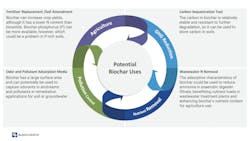Solids management at a crossroads: solutions in an age of uncertainty
Cleaning our nation’s wastewaters inevitably leads to waste solids and, for the last half century, landfilling, incineration and land application have been the dominant outlets for these products. Regulatory trends historically have impacted the relative allocation to each outlet however, and before the promulgation of new federal rules for land application in 1993, most solids were managed via landfilling or incineration. Those rules (40 CFR 503) drove a trend that continues today, with most solids now land applied for beneficial use in the U.S.
The sustained dominance of beneficial use reflects two key drivers in solids management: resource recovery and climate change mitigation. Biosolids — wastewater solids treated to allow their application for agricultural and urban landscape uses — have long been valued as a source of renewable nutrients for the soil. The organic matter they contain also is a major reason they are beneficial as a soil amendment. Land-applied biosolids improve drought resistance, soil structure and microbial communities. From a climate change perspective, biosolids offset greenhouse gas intensive fertilizer production, sequester carbon in the soil and, when applied to the land instead of disposed in landfills, reduce greenhouse gas emissions (methane) from landfills.
Today, however, land application is facing unprecedented challenges. While the long-standing prevalence of this practice appears to be in question — other outlets are facing challenges as well.
Pressures across all solids outlets
Land application is currently limited in some areas by phosphorus restrictions, but emerging contaminants are a broader concern, especially per- and polyfluoroalkyl substances (PFAS). These ubiquitous compounds can be found in food packaging, textiles, cosmetics, firefighting foam and other sources. They enter wastewater influent through industrial discharges, landfill leachate and residential contributions. Conventional water resource recovery facilities (WRRFs) do not destroy these compounds, so PFAS are found in liquid effluents and solids from WRRFs.
PFAS management is a priority for U.S. Environmental Protection Agency (EPA), which set forth a multi-year plan to address these compounds in its PFAS Strategic Roadmap, with actions and activities focused on source reduction, remediation and research. With respect to biosolids land application, a PFOA and PFOS risk assessment is expected to be published in a draft in summer of 2024 and finalized by the end of 2024. The risk assessment does not establish limits, per se, but is a step on the path to setting limits for these compounds if risk management analyses by EPA indicate limits are warranted.
The roadmap also set forth EPA plans, now included in a final rule, to include PFOA and PFOS as hazardous substances under the Comprehensive Environmental Response, Compensation and Liability Act (CERCLA). This action has raised concerns not only for land application, but for landfilling as well. A primary concern is that both WRRFs and landfills are PFAS “receivers,” and the amount of PFAS exiting these facilities in effluent, solids or leachate is driven by the concentrations coming in via influent or landfill wastes. Burdening these facilities with PFAS control costs under CERCLA would deviate from the “polluter pays” principle on which CERCLA was founded.
EPA has noted that utilities are not an enforcement focus for this rule, but potential third-party litigation is still a dominant concern. To address these concerns, utilities and landfill owners are exploring legislative remedies that reflect their role as PFAS receivers. For land application, utilities are looking to exemptions currently within CERCLA that protect activities such as permitted releases, recycling activities and normal fertilizer use, as well as the domestic sewage exclusion.
In addition to CERCLA, EPA’s expected Effluent Limitation Guidelines (ELGs) for landfill leachate are expected to pressure both utilities and landfill operators. The new ELGs, delayed from January 2024 to potentially the end of the year, may require landfills to treat their leachate before discharge or reduce the material they accept that may contain PFAS. This requirement may impact wastewater utilities by driving up landfilling costs and reducing the willingness of landfills to accept wastewater solids.
Utilities wishing to move away from land application to landfilling because of PFAS concerns may be hindered by another trend: restrictions on high moisture content waste (HMCW) acceptance at landfills. In response to stability and other issues, some landfills have limited the quantity of HMCW (such as wastewater solids) accepted at their facilities or have increased costs to handle these materials. In Georgia, these concerns have driven requirements for landfills to produce a HMCW management plan detailing mitigation strategies for landfills receiving more than 5% HMCW. These requirements are impacting landfilling costs, sometimes dramatically, and the potential leachate requirements noted above may exacerbate this cost increase.
Of the three outlets for solids, incineration has seen — so far — the fewest changes with respect to new regulations and trends. This may reflect the massive impacts of regulatory changes years ago for sewage sludge incinerator (SSI) emissions. But it is worth noting that PFAS emissions from incinerators have been a topic of great interest, with some wondering if PFAS might be destroyed at the typical operating temperatures for SSIs. Preliminarily research has indicated that SSIs substantially reduce the mass of PFAS emitted. SSIs transform larger PFAS compounds into smaller compounds, and the mass loading of PFAS in the SSI stack is only 5% of the influent mass loading. Should there be a renewed focus on incineration, concerns remain regarding the feasibility of building new SSIs. However, historically, public opposition makes siting new facilities difficult, and their costs are very high.
In sum, solids management is facing challenges in all areas, but with respect to PFAS, there are approaches to mitigate risk.
Tools to navigate a changing regulatory landscape
With respect to PFAS management in municipal wastewater solids, there are two strategies to consider as an industry to mitigate the risk associated with these compounds. The first is to ensure that these compounds are dealt with at their sources by targeting industrial discharges to the sewer system to reduce concentrations entering WRRFs to levels more synonymous with domestic sewage. This type of pragmatic approach is evident in states such as Michigan, Colorado and New York that all have implemented — at least as an interim measure — trigger levels in biosolids that, if exceeded, initiate additional investigation and mitigation of industrial discharges to the sewer system in question.
The second strategy is to treat solids to remove PFAS. Emerging thermal conversion processes such as pyrolysis, gasification and supercritical water oxidation (SCWO) have shown promise for removing PFAS from the solids.
However, the overall fate of PFAS through some of these processes has not yet been established — although conditions in SCWO do indicate that PFAS should be mineralized — and these processes are not yet well proven, with a limited number of full-scale installations operating on wastewater solids as a feedstock. Additionally, markets for products such as wastewater solids-derived biochar (from pyrolysis and gasification) are emerging, and some markets are not land-based.
For agricultural purposes, however, it is important to note that the nitrogen content of biochar is significantly lower than traditional biosolids products and, as a result, the potential for offsetting fertilizer production through agricultural use of biochar is less than traditional biosolids beneficial use.
Nevertheless, these thermal conversion technologies are likely to play a part in the future of wastewater solids management, particularly for areas subject to high concentrations that cannot be mitigated by other means. As the industry looks to the future, it is vitally important that we maintain a holistic outlook that considers not just the risks, but the significant environmental benefits of traditional end uses of biosolids as well as looking at the merits of additional solids treatments to remove PFAS.
About the Author
Lynne Moss
Lynne Moss is a residuals and odor control practice leader in Gaithersburg, Maryland.
Greg Knight
Greg Knight is a biosolids and residuals solutions lead based in Atlanta, Georgia.
Patrick McNamara
Patrick McNamara is a PFAS and residuals research leader in the Milwaukee, Wisconsin.



